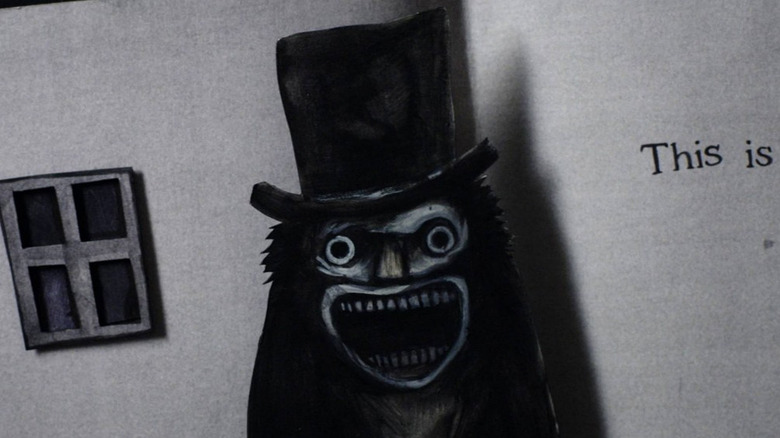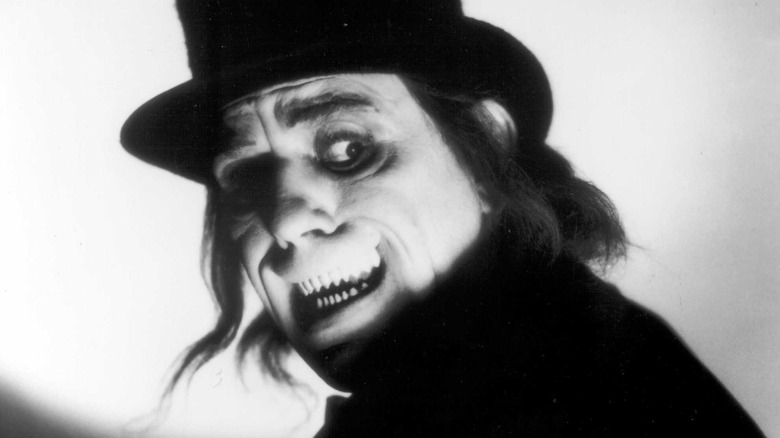The Babadook's Design Was Inspired By A Silent Film Legend
"If it's in a word, or it's in a look, you can't get rid of the Babadook."
It's the bedtime story from hell. One of modern horror's latest icons — spooky enough to give the director of "The Exorcist" the heebie jeebies — may be fresh and freaky, but its look takes a cue from the old school. Jennifer Kent's 2014 psychological horror feature, "The Babadook," delivers its scares twofold: through its increasingly aggressive and exhausted single mom protagonist Amelia (Essie Davis), and the Babadook, a humanoid figure who likes tall hats and fat rhymes.
The figure comes to the struggling mother and son Samuel (Noah Wiseman) at a time when Amelia is mentally near the end of her rope. Not only can't she fully process the death of her husband (which happened on the way to deliver infant Sam), but motherhood isn't the constant blessing many make it out to be, and Sam is responding to the vibe shift with increasingly erratic behavior. That's when a pop-up book, titled "Mister Babadook," appears to the pair, and their greatest trial begins.
In crafting a physical pop-up book for the film, artist Alex Juhasz describes his approach to depicting the Babadook:
"The Babadook is made of shadows. It's a creature's idea of a person. I did a lot of iterations of him before finding a design that was sufficiently unsettling."
Sporting a bizarre, ultra-wide grin with an unsettling amount of small, sharp teeth, all under a wild-eyed face with a comically tall hat, the Babadook is the stuff of German expressionist nightmares. Can you guess the Lon Chaney character who provided inspiration for the uncanny grin?
London After Midnight
If you guessed that the Babadook was inspired by Lon Chaney's look in "ThePhantom of the Opera," you'd be devastatingly close. Instead, move up a couple of years to Tod Browning's 1927 silent mystery-horror "London After Midnight." Chaney plays dual roles as both an investigator and a vampiric figure known as the Man in the Beaver Hat. The film is considered lost following the destruction of the last known copy in the 1965 MGM vault fire (nitrate film, it turns out, is highly flammable). One doesn't need to see the movie to behold the nightmare fuel contained in even a single image of Chaney in full wardrobe and makeup as the Man in the Beaver Hat, or the aesthetic kinship between this villain and Kent's. Both sport a face that's sort of human, but not quite, an image that Kent said "really impressed itself upon me" [via Mountain Xpress].
Reviews of "London After Midnight" were mixed to positive, though many concede it's not Browning's best work. Los Angeles Times critic Norbert Lusk wrote in 1927:
"'London After Midnight' is conceded to be their best since 'The Unholy Three' which, it seems, will always be the criterion by which Lon Chaney's pictures will be measured. The new one has not the same degree of human interest found in the earlier picture, nor its diabolic humor but it is mysterious, grewsome [sic], and closely knit."
A bonus for horror heads: Scott Derrickson's "The Black Phone," an upcoming Blumhouse-backed adaptation of Joe Hill's short story of the same name, features a child-killing baddie known as The Grabber whose mask (designed by special effects legend Tom Savini) might look familiar to those who have beheld the Man in the Beaver Hat.

